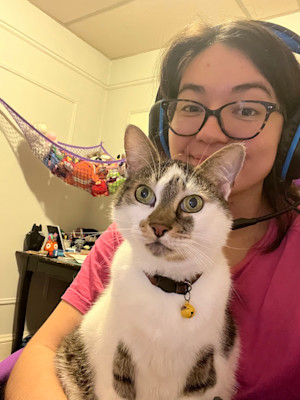1 in 4 People Don’t Know When Their Cat is Mad, New Study Finds
You might not be as good at reading feline behavior as you think.

Share Article
I’m pretty confident that I can understand what my cat is trying to tell me. After all, I’ve lived with him for almost 10 years now, so I like to think that I know which meow means “Feed me, Mom!” and which meow means “I threw up.” I know I’m not alone — we all like to think we comprehend our pet’s secret language. But according to a new studyopens in new tab published in Frontiers in Ethology, humans aren’t as good at understanding cats as we like to think. The study found that one in four adults misread feline communication, especially when cats are trying to convey discomfort.
The study was conducted online with 368 adult participants. After answering questions about their experience and knowledge of cats, the participants watched a series of 10 short videos of humans and cats playing together. For each video, they were asked to categorize the interaction as “overall positive,” “overall negative,” or “unsure.” They were also asked to categorize the cat’s mood based on one of ten options: happy, curious, frustrated, angry, relaxed, bored, stressed, playful, scared, or other.
Participants were then asked to select how they would react in the situation depicted in the video and given a list of nine actions to choose from: stroking the cat, picking the cat up, rubbing the cat’s belly, playing with the cat using their hands, playing with the cat using a toy, disciplining or correcting the cat, staying near but not interacting with the cat, walking away from the cat, or “other.”
The researchers found that 23.3 percent of study participants did not register the cats’ negative moodsopens in new tab when the cats exhibited clear signs of discomfort, such as hissing and flattened ears. When it came to more subtle body language cues like tense posture or altered whiskers, the number jumped to 48.7 percent.
How much do you spend on your pet per year?
Next, half the participants watched an educational video about cat body language during play; the control group watched a video on general cat care such as litter maintenance. The research team wanted to see if the short training would affect how the participants analyzed the cats’ body language.
Those who watched the educational video reported a significant increase in confidence — but the lesson didn’t do much to help their comprehension. In fact, while the training video had a slight positive effect in helping participants notice clear negative signals, the participants’ ability to identify more subtle body language dropped by 18.8 percentage points.
The most alarming finding was that even when participants correctly recognized negative behavior, many still opted to continue interacting with the cat. In fact, 44.4 percent of those who managed to notice the subtle negative cues still chose to engage further. The researchers flagged these two separate issues — failing to identify negative signals in cats and choosing to continue interaction even after identifying stressed behavior — as distinct problems with different solutions.
“In the case of those that cannot recognize distancing cues, education would first need to improve understanding of cat behaviors,” Julia S. L. Henning, the study’s lead author, wrote. “While in the case of those who can recognize cues, education may need to be more individualized, first establishing any narratives that may be maintaining poor interaction choices (e.g. the person thinks that a cat in a negative state needs comforting through touch) and correcting these narratives to reduce unwanted interactions.”
Continuing to interact with a stressed out cat can have negative consequences for both humans and animals. Disturbingly, 42 percent of participants said they would pet the belly of a cat who exhibited negative signals. Many humans misread an exposed belly as an invitation to touch — and while it can be an invitation for connection, it can also be a defensive position, since rolling over makes all four claws available for attack. Overstimulated cats often scratch or bite, so petting an anxious cat’s stomach is ill-advised.
And it’s not just scratched and bitten hands that cat parents have to worry about. Cats who experience repeated stress may develop behavioral and health issues. Continuing to overstimulate an already nervous cat will only make the situation worse; it’s important to give plenty of space to a cat who seems stressed.
While it can be tempting to try to “apologize” to your cat by giving them extra pets, we have to remember that cats aren’t humans. They have a different way of communicating, and sometimes that means the best thing you can do to say sorry for overstimulating them is simply stepping away. Your cat will thank you. And next time you play together, it might help to not assume you know what they want. They’re even more mysterious than you guessed.

Petrana Radulovic
Petrana Radulovic is a New York City-based writer who focuses on entertainment and culture beats. In her free time, she writes fiction, sings karaoke, and tries new recipes. Her work has appeared in Polygon, IGN, Reactor, and more. She lives with a very affectionate cat named Bagel, who loves head kisses and meeting people at parties. He is smart enough to open cabinets but still too dumb to understand stairs.
Related articles
![Woman cuddling her dog at home.]()
Is Your Pet Actually Stressed Out, or Are You Just Projecting?
How to know when it’s real—and time to call the vet.
![Bored gray cat at home.]()
What Really Happens to Your Cat When You’re Too Busy to Play With Them
For starters, get ready to clean up some messes.
Can Cats Have Panic Attacks?
How to know something more serious isn’t going on.
![Red cat with squinted eyes laying in a basket closeup]()
6 Ways Your Cat Could Tell You They Are in Pain
Here are all the way your kitty is trying to tell you they’re hurting.
![]()
How to Read Your Cat’s Poker Face
A guide to their not-so-secret tells.
![Two cats walking with their tails sticking straight up]()
Tail Talk: What Is Your Cat Trying to Tell You?
Cats are enigmas. But their tail movements can reveal a lot about their moods





